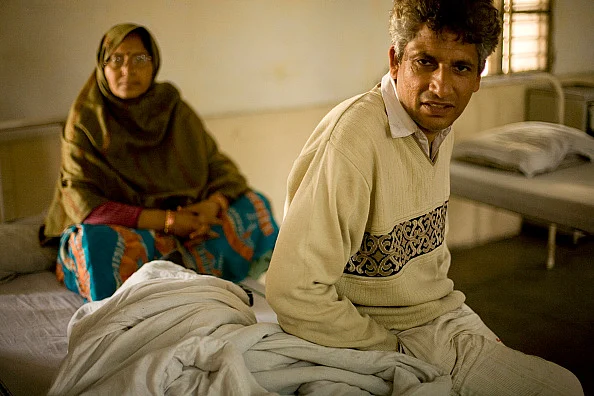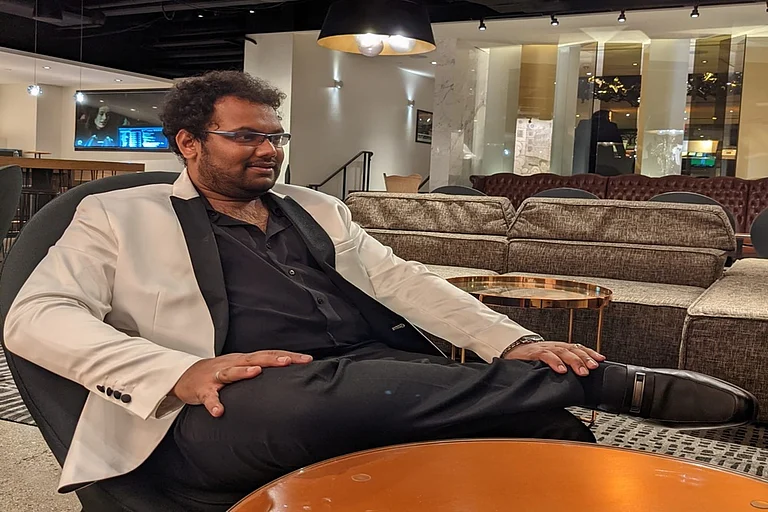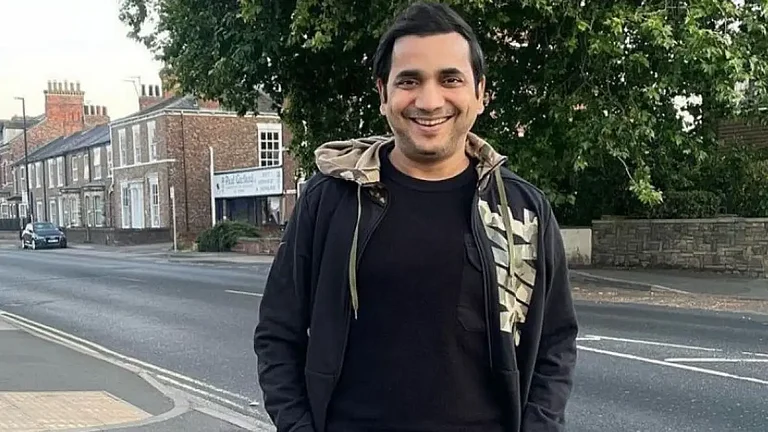50-year-old Palani (name changed) has vague memories of his life. He was born in Madurai, Tamil Nadu but he doesn’t remember when. He had a sister and at the age of 18, he went to prison for killing her father-in-law after she confided in him about domestic abuse she suffered at the hands of her in-laws. Palani was sentenced to life imprisonment and spent 15 years in jail. After his release, he never returned to his family but thy refused to accept him. For years, Palani wandered on the streets of Kerala where he eventually arrived, with no care or medication and no one to even speak to. So, he spoke to the voices in his head and they spoke back. Palani, who was eventually found by some social workers who took him to a shelter home for homeless and mentally ill in Mammlapuram, Kerala, was later diagnosed with schizophrenia, a chronic brain disorder that affects over 3 million people in India.
Mental disorders are among the leading causes of non-fatal disease burden in India. Prof Lalit Dandona, Indian Council of Medical Research, in 2017 published a government funded research paper in which he analysed the prevalence and disease burden of each mental disorder for the states of India, from 1990 to 2017. He noted that in 2017, 197.3 million Indians had mental disorders, including 45.7 million with depressive disorders and 44·9 million with anxiety disorders. This means that one in seven Indians were affected by mental disorders of varying severity in 2017.
The Covid-19 pandemic also led to a global mental health pandemic with the Economic Survey of India 2024 highlighting the increasing “prevalence of poor mental health among adolescents (in India) exacerbated by the COVID-19 pandemic, with 11 percent of students reported as feeling anxious, 14 percent as feeling extreme emotion and 43 percent experiencing mood swings”. The pandemic also adversely impacted large proportion of socially and economically vulnerable populations like the children, the elderly, migrant labourers, and those with pre-existing mental illnesses.
The State runs institutions such as mental hospitals, psychiatry departments in medical college hospitals to cater to mental health needs along with governmental organizations (NGOs) and private mental health practitioners delivering mental health services.
Though there are 40 odd mental hospitals in India and few other facilities offer inpatient care, a majority offer only urban-based outpatient care. Most centres do not offer psychosocial rehabilitation services studies show that a majority of persons with severe mental illness (PSMi) live with their families or are, like Palani, are abandoned for years due to lack of understanding of mental health issues or availability of affordable, long term treatment and rehabilitation options, forcing many like Palani to wander the streets for years.
A Collective Responsibility
Today, Palani lives inside a shelter home called with four other peers in the “Home Again” centre run by the Chennai-based non-profit organisation The Banyan. The program, which includes 128 centres spread across ten Indian states, Sri Lanka and Bangladesh, offers inclusive living options free of cost for persons living with mental illness, especially those from vulnerable backgrounds. Most of the inmates like Palani are schizophrenic. Some, like his friend Bablu, have severe BPD (borderline personality disorder) while others like Abdu, a former victim of child trafficking and abuse, who recovered and now works at a supermarket. “But I like coming back to Home Again. This is my home now,” he said. Most of them continue to live in these centers for two reasons: either their families are unwilling to accept them back, or, in some cases, though the families are welcoming, the individuals struggle to cope with family life or returning to their previous identities. "They don't find themselves fitting into conventional familial structures or follow societal norms. We have found cases where they relapse and have to be readmitted to the Emergency Care and Recovery Centre," explains a social worker working with the Banyan.
Inclusive spaces like the Home Again centres are few and mostly anchored by civil society. Despite having a strong mental health policy, the Indian State fails to provide adequate mental healthcare services and/or equitable access to existing ones to a majority of Indians facing mental illness.
As per The National Mental Health Survey of 2015-16, at least 150 million Indians are estimated to have mental health issues. "Yet 83 percent lack the necessary care,” says mental health activist and Banyan Deputy Director Mrinalini Ravi, highlighting the issue of treatment gap is a major roadblock to mental healthcare access in India. The low-resource scenario is compounded by socio-economic liabilities like gender, caste, and class, rendering people with psychosocial disabilities homeless, with limited options of long-term institutionalisation or living on the streets. Founded by social workers Vandana Gopikumar and Vaishnavi Jayakumar, the Banyan provides comprehensive mental health services in a range of institutional and community settings for PSMis issues living in homelessness and poverty. These include running centres for providing hospital-based care, communitarian therapy, rehabilitation and rehoming programs and more. By trying to invert the prevailing pattern of top-down program implementation for mental healthcare, the organisation has tried to reverse the marginalisation of the perspectives expressed by people with lived experiences with mental health issues.
When it comes to women across demographics, there is the additional and generational burden of patriarchy. Ravi says that marginalised or homeless women face compounded exclusionary factors, notably the absence or scarcity of resources or safe shelter and support systems. “In an environment devoid of these basic rights, mental stress is exacerbated. Moreover, women from these settings are often anonymised by society, have histories of trauma, and are stripped of power and agency, making them vulnerable to repetitive patterns of exploitation, to recurrent abuse and violence, often sexual in nature,” Ravi states. When it comes to homeless women, the resultant trauma from these multiple violations, including the spectrum of trauma endured on the streets, can trigger mental health issues.
The treatment gap is defined as the proportion of people who meet diagnostic criteria for a given disorder whose condition is untreated. It is a direct marker of the degree of equitable access available for mental healthcare services in a country and also the prevalent attitudes on mental health held by the State and general populace.
Delhi-based former Institute of Human Behaviour and Allied Sciences (IHBAS) director and psychiatrist Dr Nimesh Desai defines access to mental healthcare in three broad stages. The first step is for patients to identify the issue as a mental health problem and seek treatment. The second stage is the patient sustaining treatment and benefitting from it. The third stage is for people with debilitating mental health issues who require intensive care and/or rehabilitation. “A majority of Indians suffering mental illness never reach the first stage. Out of the few that do, even fewer get through the second stage,” he said.
Reasons for quitting treatment in stage two range from financial burden to stress of treatment, stigma or simply loss of faith in the treatment which arises due to ignorance about issues surrounding mental health, Desai states. Those relying on subsidised healthcare in government-run establishments like IHBAS have to spend long hours in queues and wait for days to get an appointment. Ramesh (name changed) who has been coming to IHBAS from Meerut for two months to get treatment for his bipolar, obsessive-compulsive father, states that though IHBAS has good doctors, the process of admissions is time-consuming and tedious. Due to shortage of doctors, it might take weeks to get an appointment. “I work in a shop and get monthly wages. Every time I come here, I have to miss a day or two of work for which I get pay cuts. This type of burden is not very sustainable and father needs long term care. I want to admit him to IHBAS but they do not have any permanent wards. There are no other affordable private centres nearby,” Ramesh said while waiting for his turn to meet the doctor in the cavernous hall of the colonial era hospital in Shahadra.
About 30 kilometres away in Greater Noida, inside the Vishwas Rehabilitation Centre operating under the Richmond Fellowship Society, free day care services are offered for mental health. The unaided civil society organisation runs a “halfway home” and is soon planning to start a “Full Stay Home” for the mentally unwell and in need of prolonged treatment and assisted living. Vishwas offers air conditioned rooms, freshly prepared meals and snacks, round the clock care, rehabilitation and constant supervision in a communitarian environment for patients whose families can afford to and are willing to cough up the approximate monthly cost of Rs 45,000. Capt Ashok Marwaha, current President of Vishwas, states that apart from donations, the spending by families of PMIs is Vishwas’s only source of income. “Apart from Corporate Social Responsibility (CSR) funds, the government does not offer any incentives to unaided NGOs like us working in mental health, despite the dire need for such services across strata,” he said. The former Navy captain said that bureaucratic red tape is also a persistently frustrating hindrance to smooth operation. “Licence renewals can be lengthy, local district authorities are often uncooperative and the exhaustive paperwork is tedious. What is worse, though, is the apathetic sensitivity or understanding of mental health among most government officials,” he adds.
Experts feel that mental health care is a collective responsibility. Just as the problems are complex and a result of systemic injustices, the solutions too require state, non-state, private and community participation to be meaningful. But so far, only a few states in India have come forward in terms of policy initiatives. Tamil Nadu has been leading the way, becoming the first state in the country to develop and release its state mental health policy in 2019. Moreover in 2024 released and formalised a separate policy focussing specifically on homeless persons living with mental health issues. In a pioneering move, Kerala adopted UNARV, a model for adolescent mental health in schools at a district level in 2007 which provided counselling and support from teachers trained in adolescent developmental psychology to students from Class 8 to 12 with behavioural and academic issues. Further treatment and therapy was also warranted in cases where it was necessary. Kerala is also among the states with the highest budgetary allocation for mental. Most states, however, do not have state level policies or action plans to implementation of union government measures like the National Mental Health Policy in 2014 and the Mental Healthcare Act (MHA) in 2017. Mental healthcare experts feel that while certain aspects of the new policies have been beneficial, many problematic areas remain unaddressed.
While the MHA in theory aims to aid welfare of PMIs and is well meaning in theory, it fails to grasp the complex nature of mental health issues and service delivery. For starters, its definition of mental health excludes disorders like conversion disorder, panic disorders, and personality disorders which are mental illnesses as per the International Classification of Diseases (ICD). Moreover, according to the act, admission and mode of treatment are in the hands of the patient, even as planning of discharge is in the hands of psychiatrists to avoid premature discharge of the patients. These rules can be a double edged sword.
While giving patients the right to consent for admission into a mental institute or hospital is a step in the right direction in terms of fostering agency and dignity of the patients, educational, socioeconomic, and cultural background of patients varies, in turn impacting the kind of decisions they make, says deveolpment communications expert and a volunteer mental health worker Mridula Seth. When it comes to PMIs, especially from marginalised strata, many may or may not be fully capable of understanding or accepting the need for treatment and may not be capable of making complex decisions about healthcare on their own, precisely due to their disorders or due to lack of awareness about their condition. “There is a lot of self stigma attached with mental health and many people often refuse to admit there is anything wrong with them as they don’t want to be called “mental” or “pagal” (mad), as such persons are often societally categorised.
Stakeholders including caregivers add that the act gives more emphasis on the legal aspects like maintaining paperwork, uploading documents, and multi-sectoral communications, often at the cost of important clinical time. Shelling money also does not always solve the problem, states Shubhra, who has been battling with her sister’s Schizoaffective disorder for years and is at present the sole carer of the patient. Shubhra, who currently lives in France while her sister Krishna stays in a shelter home in Kolkata, can afford premium treatment and is currently in Delhi to shift her out of Kolkata and into Vishwas. However MHA's admission and carer rules remain an issue as one of the rules necessitates a local guardian for institutionalizing mental health patients. “What about patients whose families live abroad? There is no provision to keep them in a rehabilitation shelter or home.”
Critics also point out that while the government’s vision for developing a mental healthcare infrastructure may be lofty, low budgetary allocations, lack of training or sensitivity among government staff and lack of trained counsellors and doctors/MDs in government-run establishments are key reasons why mental health remains on the back burner. In 2021, there were 0.75 psychiatrists per lakh population in India, far below the WHO norm of 3 per lakh population. In October 2022, the Ministry of Health and Family Welfare (MoHFW) launched the Tele-MANAS (Mental Health Assistance and Networking Across States) helpline to provide toll free tele-mental health services across cities and remote regions of India. “The initiative was quite successful and we were getting thousands of calls a month from across India regarding various concerns like suicidal thoughts, addiction problems, anxiety or psychological distress,” said Desai . With 53 centres operational across states and UTs, Tele Manas has received increased budget allocation of Rs 90 crore this year as opposed to last year when it got Rs 65 crore. The programme is one of the three main line items for mental health ( along with National Institute of Mental Health and Neuro-Sciences (NIMHANS), Lokpriya Gopinath Bordoloi Regional Institute of Mental Health in Tezpur) that the government spends on. Discrepancies in state-level implementation, aspects of the program like an unclear data privacy policy and lack of trained professionals in the centres have been noted as issues that need more attention. Experts also feel that while there is a predominant focus on government facilities, particularly inpatient care, outpatient, long-term, and aftercare budgets remain severely underfunded, leaving many like Palani or Ramesh and his schizophrenic father in search of treatment in a precarious state of uncertainty about their future.
(With inputs from Shahina KK)


















